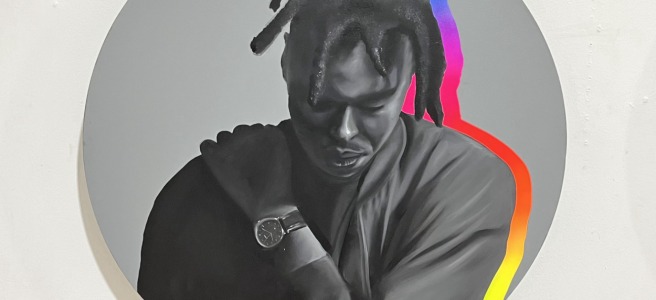It is no surprise that the art world has met a racial reckoning since Trumpism. A year on, many minority artists are featured in venerable institutions. If we think about the intricate relationship and influence between patrons, curators and artists, and realize that the former two groups are still largely white, we begin to wonder if much of the African American voice has been tunnel-visioned into a narrow narrative, to fit in the cultural and political discourse of our times.
Jeremy Biggers’ exhibition at 500X gallery begs to differ. In his own words, “as Black men, there often isn’t space for us to talk about our insecurities. I’ve had body image issues for years and felt like I needed to deal with it in silence. Upon realizing this wasn’t an exclusive experience to me, I realized that as Black men we often carry unspoken burdens because on top of having insecurities like everyone else, we often feel we can’t show moments of vulnerability because we need to be the stoic rock that gives our families ‘security,’ be that financial, emotional or physical, in a world that is at all times a threat to our very existence.”
In essence, Biggers paints black men as human first. To achieve that, he eliminates the context and, to some degree, even color. Biggers’ ability to render facial features without colors for skin tone helps downplay racial identity. Each sitter is placed against an empty background. They turn, ponder or look away while shouldering the burden of social and familial expectations.
Despite the common theme in sleek streetwear and marvelous execution, Biggers’ work is antithetical to Kehinde Wiley’s boisterous, exuberant and larger-than-life portraits. And it’s soothing to the eyes. After all, without pretense, life itself is interesting enough.
The colors, either added as neon abstract dots or bright shadows against a monochrome painting, give the work a commercial flare. At least it would have some advantage in an art show – those pop colors strike out from afar. Aside from aesthetics and technical consideration, if they bring anything else to the main subject, that is to make black men even harder to see. They force you to look deeper underneath the glitz and glamor. It is in those enclosed arms, hands combing through hair and downward gazes that Biggers finds a visual vocabulary of his own in portraying black – no traumatic undertones, no social commentary and no glorification.
You can see more of his work here.
Discover more from Urban Art & Antiques
Subscribe to get the latest posts sent to your email.


